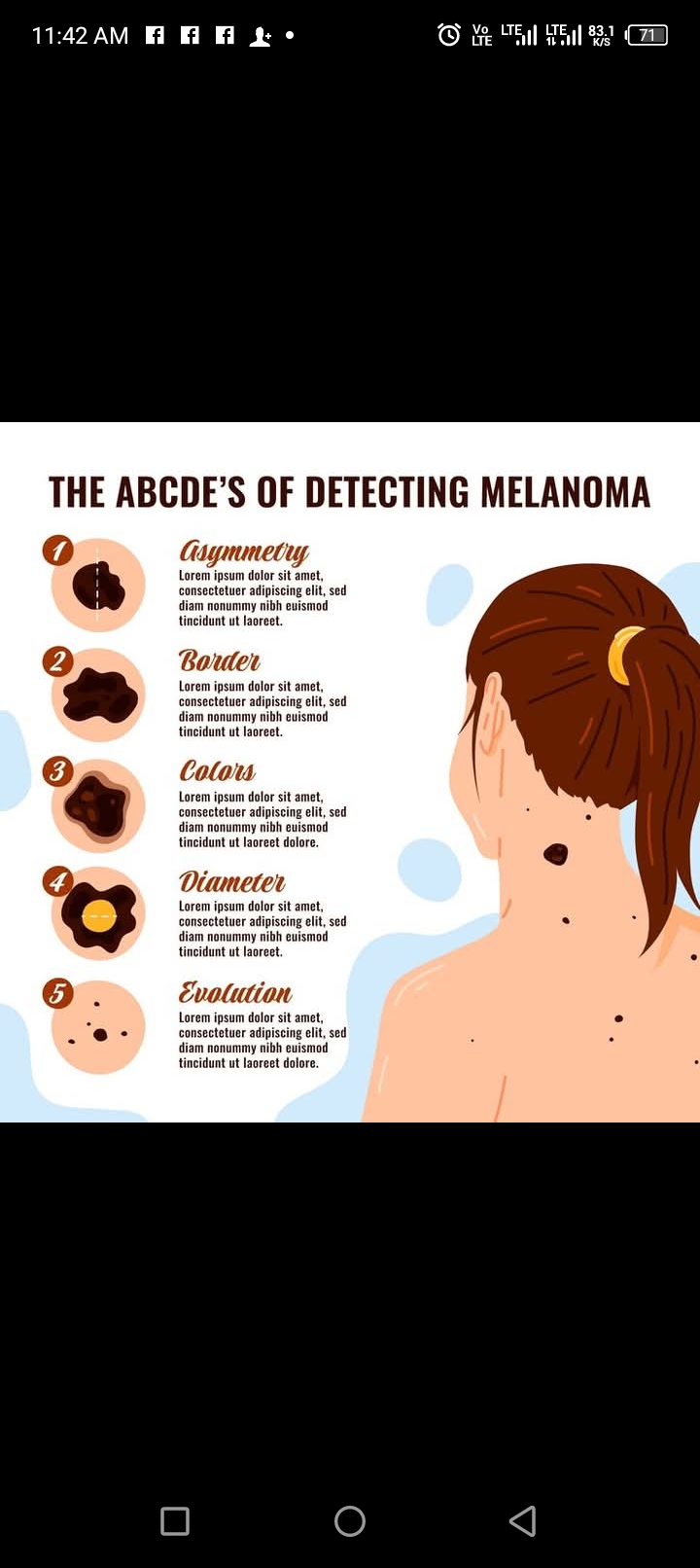#melanomaawareness #skinhealth #SunSafety #healthtips #skincareroutine #preventcancer
Melanoma: Signs, Symptoms, and Causes
Signs and Symptoms
1. Unusual Moles: Melanoma often begins as a change in a mole or a new, unusual growth on the skin. Look for the ABCDEs:
o Asymmetry: One half of the mole doesn't match the other.
o Border: Edges are irregular, ragged, or blurred.
o Color: The mole has various shades of brown, black, or sometimes patches of red, white, or blue.
o Diameter: Larger than 6mm (about the size of a pencil eraser).
o Evolving: Changes in size, shape, color, or elevation, or new symptoms like bleeding, itching, or crusting.
2. New Growths: Any new spot on the skin or an existing spot that starts to grow or change significantly.
3. Itching or Tenderness: A mole that becomes itchy, tender, or painful.
4. Bleeding or Oozing: Moles that ooze or bleed without apparent injury.
Causes
1. UV Radiation: Exposure to ultraviolet (UV) radiation from the sun or tanning beds is a primary risk factor.
2. Genetics: Family history of melanoma increases risk.
3. Skin Type: Fair skin, light hair, and light eyes increase susceptibility due to lower melanin levels.
4. Moles: Having many moles or unusual types of moles (dysplastic nevi) increases risk.
5. Weakened Immune System: Conditions or medications that weaken the immune system.
6. Age: Higher incidence in older adults, though it can occur at any age.
7. Chemical Exposure: Exposure to certain chemicals like arsenic.
Prevention Tips:
• Avoid peak sun hours (10 AM to 4 PM).
• Use broad-spectrum sunscreen with SPF 30 or higher.
• Wear protective clothing, hats, and sunglasses.
• Avoid tanning beds.
• Regular skin checks and dermatologist visits for early detection.
Stay informed and protect your skin!
Melanoma: Signs, Symptoms, and Causes
Signs and Symptoms
1. Unusual Moles: Melanoma often begins as a change in a mole or a new, unusual growth on the skin. Look for the ABCDEs:
o Asymmetry: One half of the mole doesn't match the other.
o Border: Edges are irregular, ragged, or blurred.
o Color: The mole has various shades of brown, black, or sometimes patches of red, white, or blue.
o Diameter: Larger than 6mm (about the size of a pencil eraser).
o Evolving: Changes in size, shape, color, or elevation, or new symptoms like bleeding, itching, or crusting.
2. New Growths: Any new spot on the skin or an existing spot that starts to grow or change significantly.
3. Itching or Tenderness: A mole that becomes itchy, tender, or painful.
4. Bleeding or Oozing: Moles that ooze or bleed without apparent injury.
Causes
1. UV Radiation: Exposure to ultraviolet (UV) radiation from the sun or tanning beds is a primary risk factor.
2. Genetics: Family history of melanoma increases risk.
3. Skin Type: Fair skin, light hair, and light eyes increase susceptibility due to lower melanin levels.
4. Moles: Having many moles or unusual types of moles (dysplastic nevi) increases risk.
5. Weakened Immune System: Conditions or medications that weaken the immune system.
6. Age: Higher incidence in older adults, though it can occur at any age.
7. Chemical Exposure: Exposure to certain chemicals like arsenic.
Prevention Tips:
• Avoid peak sun hours (10 AM to 4 PM).
• Use broad-spectrum sunscreen with SPF 30 or higher.
• Wear protective clothing, hats, and sunglasses.
• Avoid tanning beds.
• Regular skin checks and dermatologist visits for early detection.
Stay informed and protect your skin!
#melanomaawareness #skinhealth #SunSafety #healthtips #skincareroutine #preventcancer
⭐⭐Melanoma: Signs, Symptoms, and Causes
🔶Signs and Symptoms
1. Unusual Moles: Melanoma often begins as a change in a mole or a new, unusual growth on the skin. Look for the ABCDEs:
o Asymmetry: One half of the mole doesn't match the other.
o Border: Edges are irregular, ragged, or blurred.
o Color: The mole has various shades of brown, black, or sometimes patches of red, white, or blue.
o Diameter: Larger than 6mm (about the size of a pencil eraser).
o Evolving: Changes in size, shape, color, or elevation, or new symptoms like bleeding, itching, or crusting.
2. New Growths: Any new spot on the skin or an existing spot that starts to grow or change significantly.
3. Itching or Tenderness: A mole that becomes itchy, tender, or painful.
4. Bleeding or Oozing: Moles that ooze or bleed without apparent injury.
🔶Causes
1. UV Radiation: Exposure to ultraviolet (UV) radiation from the sun or tanning beds is a primary risk factor.
2. Genetics: Family history of melanoma increases risk.
3. Skin Type: Fair skin, light hair, and light eyes increase susceptibility due to lower melanin levels.
4. Moles: Having many moles or unusual types of moles (dysplastic nevi) increases risk.
5. Weakened Immune System: Conditions or medications that weaken the immune system.
6. Age: Higher incidence in older adults, though it can occur at any age.
7. Chemical Exposure: Exposure to certain chemicals like arsenic.
🔶Prevention Tips:
• Avoid peak sun hours (10 AM to 4 PM).
• Use broad-spectrum sunscreen with SPF 30 or higher.
• Wear protective clothing, hats, and sunglasses.
• Avoid tanning beds.
• Regular skin checks and dermatologist visits for early detection.
⭐Stay informed and protect your skin! 🌞🕶️




